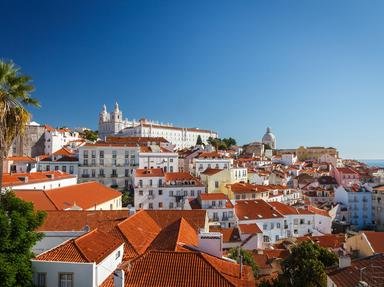Quiz Answer Key and Fun Facts
1. You have arrived at Lisbon, the country's capital, and are looking at a tower that is a World Heritage Site, as well as a symbol of Portugal's seafaring past. It is called the Tower of ___.
2. You leave Lisbon behind and head north for another World Heritage Site. Representative of the 19th century romantic era, this small village, with its palaces and gardens at the foothill of a mountain range, was described by Lord Byron as the most beautiful in the world.
3. You keep heading north and find yourself looking at the final resting place of D. Pedro I and the Lady Inês de Castro, the most tragic romantic figures in Portuguese history. The lady was killed by order of D. Pedro's father, and he is said to have married her after her death. They rest at which World Heritage Site?
4. You hear some stories about hidden treasure and decide to head east to Tomar, where you hope to find some clues to the holy grail, the philosopher's stone or some other Templar-buried treasure in which World Heritage Site?
5. You head northwest and eventually stop at another World Heritage Site, a monastery built to commemorate Portugal's victory in 1385 at the Battle of Aljubarrota against invading Castillian forces, which secured continued Portuguese independence.
6. Again you go north and arrive at the second largest city in the country. This city is the center of trade for what is considered by many the best wine in the world, which shares the city's name. The historic center of this city is also a World Heritage Site. Name the city.
7. You are now intrigued by Portugal and decide to go northeast to find what the locals call the "cradle city of the nation". This city, also a World Heritage Site, is dominated by its castle. This city is full of references to D. Afonso Henriques, the first Portuguese king.
8. You decide to go deeper into this country's history, so you head east and arrive at a valley that has been inhabited since the Stone Age. You take pictures of wonderful images you see depicted in stones. Where are you?
9. You remember that you have already visited a Portuguese city related to wines. Which wine-making region, also a World Heritage Site, is centered on a river of the same name?
10. It's almost time to go home, so you head back to Lisbon. Before saying farewell to this beautiful country, some friends take you to "listen" to a sample of Portugal's UNESCO World's Intangible Cultural Heritage. Listen? Yes, this type of music is considered "intangible" World Heritage on its own and is the most emblematic type of Portuguese music.
Source: Author
onunodnumiar
This quiz was reviewed by FunTrivia editor
Pagiedamon before going online.
Any errors found in FunTrivia content are routinely corrected through our feedback system.

